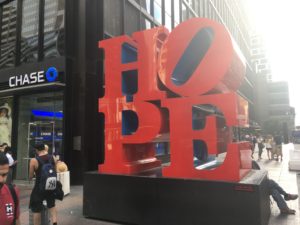
Robert Indiana’s HOPE sculpture and Chase (formerly Chemical) Bank in the Theatre District of New York City
HOPE, THE BANK, AND AMERICAN PYSCHO
There’s the hope of Emily Dickinson’s poem. “Hope is the thing with feathers.” And there’s HOPE. The work of the late pop-artist Robert Indiana on 7th Avenue and 53rd Street. The four letter sculpture with its two tiers. The “O” leaning forward.
Compared to LOVE (on 55th and 6th Avenue) HOPE is the wallflower emotion. Maybe hope is just too broad, too accommodating. One can hope to find love. But can one love to find hope? Sounds like madness. Like the theme of an under-rated recent Broadway musical that ran for just ten weeks.
If you’re a theatre aficionado with a dark side you saw the short-lived American Psycho (Spring 2016). Or as an intrepid fiction-reader you may have read Bret Easton Ellis’s controversial novel that the musical is based on.
If so, it must seem a wild coincidence to see the HOPE statue positioned on the corner near a Chase Manhattan branch. This especially if you were around in the eighties when Chemical Banks were ubiquitous in New York. Before Chemical acquired Chase Manhattan Bank in 1996 and adopted its name.
FOREBODING WORDS
American Psycho the novel (1980) opens with a run-on sentence that begins:
Abandon all hope ye who enter here is scrawled in blood red lettering on the side of the Chemical Bank near the corner of Eleventh and First and is in print large enough to be seen from the backseat of the cab as it lurches forward in the traffic leaving Wall Street [ . . . ]
DANTE’S INFERNO
The adage “Abandon all hope, ye who enter here” is in most minds a hellish reference. Google it and what you’ll find is that it goes back to Dante’s The Inferno. One of the masterpieces of world literature, Dante’s Divine Comedy was written in the early fourteenth century, completed in 1320. The Inferno is the first book, followed by Purgatorio and Paradisio. In Canto III of The Inferno, the poet Dante plays tourist (if you will) with his guide VIrgil at the Gates of Hell. Cut into stone above the gate is a portentous inscription.
I AM THE WAY INTO THE CITY OF WOE / I AM THE WAY TO A FORSAKEN PEOPLE / I AM THE WAY INTO INTERNAL SORROW
SACRED JUSTICE MOVED MY ARCHITECT / I WAS RAISED HERE BY DIVINE OMNIPOTENCE / PRIMORDIAL LOVE AND ULTIMATE INTELLECT
ONLY THOSE ELEMENTS TIME CANNOT WEAR / WERE MADE BEFORE ME, AND BEYOND TIME I STAND/ ABANDON ALL HOPE YE WHO ENTER HERE
That these words are on a stone road sign at the entrance of hell is something parodied in the modern world. We mutter the phrase abandon all hope to make light of the beginning of trouble. Whatever form it may take.
Just as Bret Easton Ellis’s fictional graffiti writer takes a Marxist shot at capitalism by spray-painting the words on the wall of a Chemical Bank. The novel, itself, is a journey through hell on earth, the over-the-top materialism of Wall Street during the Reagan Era. The novel’s guide is Patrick Bateman. A psychotic killer who describes his grisly murders in the same bored, meticulous way he describes fashion, videotape movies, and pop music.
THE ORIGIN OF ABANDON ALL HOPE
But the origin of this saying goes back to at least to Roman times, probably centuries earlier. And its use is darkly humorous. In the third century B. C. the great author and adaptor of comedies, Plautus (Titus Maccius) uses the adage as a jest in his late comedy Bacchides. In Act III, Scene 1 one of the moral characters in the play, the tutor Lydus, comments to the audience while standing before the house of a courtesan. With a humorous lament, Lydus equates a bordello with the underworld.
Yes, a door to Hell and nothing less: / no one come this way unless he / has abandoned all hope who enters here.
This expression for misery may have been used centuries earlier than Plautus’s use of it in Bacchides circa 180 B. C. Bacchides is based on a lost play titled The Double Deceivers by the Greek comedy writer Menander who was active more than 100 years before Plautus. (See translator James Tatum’s Plautus: The Darker Comedies.)
HOPE IS WHERE YOU LOST IT
So where one enters to abandon hope is various. It can mean a bordello for ancient dramatists, the gates of hell for a medieval poet, and a bank for a twentieth century novelist. Though for the novelist Brett Easton Ellis, the loss of this basic human emotion is integral to his theme. Writing with the existential angst of Dostoyevsky, Ellis allows his sense of abandoned hope to permeate the whole American Psycho novel as Patrick Bateman makes his way through the void of his own being at the bank, in the company of prostitutes, and through his personal psychotic hell.
The abandon hope reference in American Psycho the musical occurs at 5:40 of the opening number, “Selling Out.” Watch the youtube clip of American Psycho the Musical–Selling Out
And don’t despair. There is always:


Thanks for posting. I’ve always read the “abandon all hope” directive in Dante as having a double meaning. At the beginning of the Divine Comedy, Dante (both the author and protagonist) is in a deep depression due to the state of his personal/professional (worldly) affairs. He only escapes the “dark wood” by passing through the realms of eternity, where he witnesses divine order. His witness to heaven and hell cures his worldly despair.
By the end of the poem, Dante has abandoned his “hopes” (i.e., his worldly expectations about matters that are insignificant in perspective). He understands that life serves a greater meaning than day-to-day concerns. Ultimately, he abandoned hope in favor of faith. To me, that is the message of the Divine Comedy.
An excellent comment that supplements the gist of this post meaningfully. Thanks for writing. I’m reminded of Nietzsche’s aphorism : “Faith is the suicide of reason.”